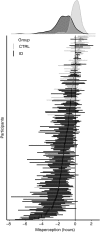Actigraphic multi-night home-recorded sleep estimates reveal three types of sleep misperception in Insomnia Disorder and good sleepers
- PMID: 31674088
- PMCID: PMC7003481
- DOI: 10.1111/jsr.12937
Actigraphic multi-night home-recorded sleep estimates reveal three types of sleep misperception in Insomnia Disorder and good sleepers
Abstract
People with Insomnia Disorder tend to underestimate their sleep compared with polysomnography or actigraphy, a phenomenon known as paradoxical insomnia or sleep-state misperception. Previous studies suggested that night-to-night variability could be an important feature differentiating subtypes of misperception. This study aimed for a data-driven definition of misperception subtypes revealed by multiple sleep features including night-to-night variability. We assessed features describing the mean and dispersion of misperception and objective and subjective sleep duration from 7-night diary and actigraphy recordings of 181 people with Insomnia Disorder and 55 people without sleep complaints. A minimally collinear subset of features was submitted to latent class analysis for data-driven subtyping. Analysis revealed three subtypes, best discriminated by three of five selected features: an individual's shortest reported subjective sleep duration; and the mean and standard deviation of misperception. These features were on average 5.4, -0.0 and 0.5 hr in one subtype accommodating the majority of good sleepers; 4.1, -1.4 and 1.0 hr in a second subtype representing the majority of people with Insomnia Disorder; and 1.7, -2.2 and 1.5 hr in a third subtype representing a quarter of people with Insomnia Disorder and hardly any good sleepers. Subtypes did not differ on an individual's objective sleep duration mean (6.9, 7.2 and 6.9 hr) and standard deviation (0.8, 0.8 and 0.9 hr). Data-driven analysis of naturalistic sleep revealed three subtypes that markedly differed in misperception features. Future studies may include misperception subtype to investigate whether it contributes to the unexplained considerable individual variability in treatment response.
Keywords: clustering analysis; objective insomnia; subjective insomnia; subjective−objective sleep discrepancy.
© 2019 The Authors. Journal of Sleep Research published by John Wiley & Sons Ltd on behalf of European Sleep Research Society.
Conflict of interest statement
All authors declare no conflicts of interest.
Figures



Similar articles
-
Methodological approach to sleep state misperception in insomnia disorder: Comparison between multiple nights of actigraphy recordings and a single night of polysomnography recording.Sleep Med. 2024 Mar;115:21-29. doi: 10.1016/j.sleep.2024.01.027. Epub 2024 Feb 1. Sleep Med. 2024. PMID: 38325157
-
Subjective-objective sleep discrepancy in patients with insomnia during and after cognitive behavioural therapy: An actigraphy study.J Sleep Res. 2020 Aug;29(4):e13064. doi: 10.1111/jsr.13064. Epub 2020 May 20. J Sleep Res. 2020. PMID: 32431047
-
Validity of a commercial wearable sleep tracker in adult insomnia disorder patients and good sleepers.J Psychosom Res. 2017 Jun;97:38-44. doi: 10.1016/j.jpsychores.2017.03.009. Epub 2017 Mar 23. J Psychosom Res. 2017. PMID: 28606497
-
The paradox of paradoxical insomnia: A theoretical review towards a unifying evidence-based definition.Sleep Med Rev. 2019 Apr;44:70-82. doi: 10.1016/j.smrv.2018.12.007. Epub 2018 Dec 25. Sleep Med Rev. 2019. PMID: 30731262 Review.
-
Subtyping primary insomnia: is sleep state misperception a distinct clinical entity?Sleep Med Rev. 2003 Jun;7(3):203-14. doi: 10.1053/smrv.2002.0253. Sleep Med Rev. 2003. PMID: 12927120 Review.
Cited by
-
Sleep discrepancy is associated with alterations in the salience network in patients with insomnia disorder: An EEG-fMRI study.Neuroimage Clin. 2022;35:103111. doi: 10.1016/j.nicl.2022.103111. Epub 2022 Jul 14. Neuroimage Clin. 2022. PMID: 35863180 Free PMC article.
-
Comparative analysis of sleep physiology using qualitative and quantitative criteria for insomnia symptoms.Sleep. 2025 Mar 11;48(3):zsae301. doi: 10.1093/sleep/zsae301. Sleep. 2025. PMID: 39713965
-
Integration of Sensor-Based and Self-Reported Metrics in a Sleep Diary: A Pilot Exploration.Behav Sleep Med. 2024 Sep-Oct;22(5):725-738. doi: 10.1080/15402002.2024.2359413. Epub 2024 Jun 12. Behav Sleep Med. 2024. PMID: 38867429 Free PMC article.
-
Spectral sleep electroencephalographic correlates of sleep efficiency, and discrepancies between actigraphy and self-reported measures, in older men.J Sleep Res. 2021 Apr;30(2):e13033. doi: 10.1111/jsr.13033. Epub 2020 Mar 21. J Sleep Res. 2021. PMID: 32198950 Free PMC article.
-
Association between sleep state misperception and bedtime behavior in patients with chronic insomnia.Sci Rep. 2024 Jun 18;14(1):13991. doi: 10.1038/s41598-024-64355-3. Sci Rep. 2024. PMID: 38886489 Free PMC article.
References
-
- American Psychiatric Association . (2013). DSM‐5: Diagnostic and statistical manual of mental disorders (5th edn). Washington, DC: American Psychiatric Press.
-
- Benjamins, J. , Migliorati, F. , Dekker, K. , Wassing, R. , Moens, S. , Van Someren, E. , …, Jarkiewicz, M. (2016). The sleep registry. An international online survey and cognitive test assessment tool and database for multivariate sleep and insomnia phenotyping (vol 14S, pg e293, 2013). Sleep Medicine, 21, 178–178. 10.1016/j.sleep.2015.11.001 - DOI - PubMed
Publication types
MeSH terms
LinkOut - more resources
Full Text Sources
Medical

